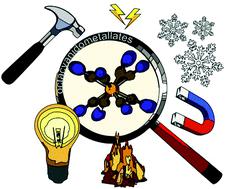当前位置:
X-MOL 学术
›
Chem. Soc. Rev.
›
论文详情
Our official English website, www.x-mol.net, welcomes your feedback! (Note: you will need to create a separate account there.)
Octacyanidometallates for multifunctional molecule-based materials.
Chemical Society Reviews ( IF 46.2 ) Pub Date : 2020-07-20 , DOI: 10.1039/d0cs00067a Szymon Chorazy 1 , Jakub J Zakrzewski 1 , Michał Magott 1 , Tomasz Korzeniak 1 , Beata Nowicka 1 , Dawid Pinkowicz 1 , Robert Podgajny 1 , Barbara Sieklucka 1
Chemical Society Reviews ( IF 46.2 ) Pub Date : 2020-07-20 , DOI: 10.1039/d0cs00067a Szymon Chorazy 1 , Jakub J Zakrzewski 1 , Michał Magott 1 , Tomasz Korzeniak 1 , Beata Nowicka 1 , Dawid Pinkowicz 1 , Robert Podgajny 1 , Barbara Sieklucka 1
Affiliation

|
Octacyanidometallates have been successfully employed in the design of heterometallic coordination systems offering a spectacular range of desired physical properties with great potential for technological applications. The [M(CN)8]n− ions comprise a series of complexes of heavy transition metals in high oxidation states, including NbIV, MoIV/V, WIV/V, and ReV. Since the discovery of the pioneering bimetallic {MnII4[MIV(CN)8]2} and {MnII9[MV(CN)8]6} (M = Mo, W) molecules in 2000, octacyanidometallates were fruitfully explored as precursors for the construction of diverse d–d or d–f coordination clusters and frameworks which could be obtained in the crystalline form under mild synthetic conditions. The primary interest in [M(CN)8]n−-based networks was focused on their application as molecule-based magnets exhibiting long-range magnetic ordering resulting from the efficient intermetallic exchange coupling mediated by cyanido bridges. However, in the last few years, octacyanidometallate-based materials proved to offer varied and remarkable functionalities, becoming efficient building blocks for the construction of molecular nanomagnets, magnetic coolers, spin transition materials, photomagnets, solvato-magnetic materials, including molecular magnetic sponges, luminescent magnets, chiral magnets and photomagnets, SHG-active magnetic materials, pyro- and ferroelectrics, ionic conductors as well as electrochemical containers. Some of these materials can be processed into the nanoscale opening the route towards the development of magnetic, optical and electronic devices. In this review, we summarise all important achievements in the field of octacyanidometallate-based functional materials, with the particular attention to the most recent advances, and present a thorough discussion on non-trivial structural and electronic features of [M(CN)8]n− ions, which are purposefully explored to introduce desired physical properties and their combinations towards advanced multifunctional materials.
中文翻译:

八氰基金属酸盐,用于多功能分子基材料。
八氰基金属酸盐已成功地用于异金属配位体系的设计中,该体系提供了令人瞩目的所需物理性能,在技术应用方面具有巨大潜力。的[M(CN)8 ] ñ -离子包括在高氧化状态,包括铌的一系列重过渡金属的配合物IV,沫IV / V,W IV / V和Re V。自发现具有开创性的双金属{Mn II 4 [M IV(CN)8 ] 2 }和{Mn II 9 [M V(CN)8 ] 6}(M = Mo,W)分子,在2000年成功地开发了八氰基金属酸盐作为构造各种d-d或d-f配位簇和骨架的前驱物,这些骨架可以在温和的合成条件下以结晶形式获得。在[M(CN)的主要兴趣8 ] ñ --基网络专注于其应用,因为基于分子的磁体表现出长程有序磁化,这是由氰基桥介导的有效金属间交换耦合产生的。但是,在过去几年中,基于八氰基金属酸盐的材料被证明具有多种不同的功能,成为构建分子纳米磁铁,磁性冷却器,自旋转变材料,光磁铁,溶剂磁性材料(包括分子磁性海绵)的有效构件,发光磁铁,手性磁铁和光磁铁,SHG活性磁性材料,热释电和铁电体,离子导体以及电化学容器。这些材料中的一些可以被加工成纳米级,从而为开发磁性,光学和电子设备开辟了道路。8 ] Ñ -离子,其有目的地探索以引入所需的物理性能和它们对先进的多功能材料的组合。
更新日期:2020-08-17
中文翻译:

八氰基金属酸盐,用于多功能分子基材料。
八氰基金属酸盐已成功地用于异金属配位体系的设计中,该体系提供了令人瞩目的所需物理性能,在技术应用方面具有巨大潜力。的[M(CN)8 ] ñ -离子包括在高氧化状态,包括铌的一系列重过渡金属的配合物IV,沫IV / V,W IV / V和Re V。自发现具有开创性的双金属{Mn II 4 [M IV(CN)8 ] 2 }和{Mn II 9 [M V(CN)8 ] 6}(M = Mo,W)分子,在2000年成功地开发了八氰基金属酸盐作为构造各种d-d或d-f配位簇和骨架的前驱物,这些骨架可以在温和的合成条件下以结晶形式获得。在[M(CN)的主要兴趣8 ] ñ --基网络专注于其应用,因为基于分子的磁体表现出长程有序磁化,这是由氰基桥介导的有效金属间交换耦合产生的。但是,在过去几年中,基于八氰基金属酸盐的材料被证明具有多种不同的功能,成为构建分子纳米磁铁,磁性冷却器,自旋转变材料,光磁铁,溶剂磁性材料(包括分子磁性海绵)的有效构件,发光磁铁,手性磁铁和光磁铁,SHG活性磁性材料,热释电和铁电体,离子导体以及电化学容器。这些材料中的一些可以被加工成纳米级,从而为开发磁性,光学和电子设备开辟了道路。8 ] Ñ -离子,其有目的地探索以引入所需的物理性能和它们对先进的多功能材料的组合。



























 京公网安备 11010802027423号
京公网安备 11010802027423号